
ЛАПРИСТА 10 мг/мл СИРОП
Спросите врача о рецепте на ЛАПРИСТА 10 мг/мл СИРОП

Инструкция по применению ЛАПРИСТА 10 мг/мл СИРОП
Введение
Проспект: информация для пациента
Лаприста 10 мг/мл сироп ЭФГ
лакосамида
Прочитайте внимательно весь проспект перед началом приема этого лекарства, поскольку он содержит важную информацию для вас.
- Сохраните этот проспект, поскольку вам может потребоваться снова прочитать его.
- Если у вас есть какие-либо вопросы, проконсультируйтесь с вашим врачом или фармацевтом.
- Это лекарство было назначено только вам и не должно быть передано другим людям, даже если у них такие же симптомы, как у вас, поскольку оно может нанести им вред.
- Если вы испытываете побочные эффекты, проконсультируйтесь с вашим врачом или фармацевтом, даже если это побочные эффекты, которые не указаны в этом проспекте. См. раздел 4.
Содержание проспекта
- Что такое Лаприста сироп и для чего он используется
- Что вам нужно знать перед началом приема Лаприста сиропа
- Как принимать Лаприста сироп
- Возможные побочные эффекты
- Хранение Лаприста сиропа
- Содержание упаковки и дополнительная информация
1. Что такое Лаприста сироп и для чего он используется
Что это такоеЛаприста сироп
Лаприста сироп содержит лакосамиду, которая относится к группе лекарств, называемых "противоэпилептическими препаратами". Эти лекарства используются для лечения эпилепсии.
- Вам было назначено это лекарство для уменьшения количества приступов, которые вы испытываете.
Для чего используетсяЛаприста сироп
- Лаприста сироп используется:
- самостоятельно и в сочетании с другими противоэпилептическими препаратами у взрослых, подростков и детей старше 2 лет для лечения определенного типа эпилепсии, характеризующегося возникновением приступов с парциальным началом с или без вторичной генерализации. При этом типе эпилепсии приступы поражают только одну сторону мозга. Однако они могут затем распространиться на более крупные области в обоих сторонах мозга;
- в сочетании с другими противоэпилептическими препаратами у взрослых, подростков и детей старше 4 лет для лечения первичных генерализованных тónico-клонических приступов (больших приступов с потерей сознания) у пациентов с идиопатической генерализованной эпилепсией (типом эпилепсии, который, как считается, имеет генетическую основу).
2. Что вам нужно знать перед началом приема Лаприста сиропа
Не принимайтеЛаприста сироп
- если вы аллергичны к лакосамиде или любому из других компонентов этого лекарства (перечисленных в разделе 6). Если вы не уверены, что вы аллергичны, проконсультируйтесь с вашим врачом.
- если у вас есть проблема с сердечным ритмом, называемая блокадой AV II или III степени.
Не принимайте это лекарство, если любой из вышеуказанных пунктов применим к вашему случаю. Если вы не уверены, проконсультируйтесь с вашим врачом или фармацевтом перед приемом этого лекарства.
Предостережения и меры предосторожности
Проконсультируйтесь с вашим врачом перед началом приема Лаприста сиропа, если:
- у вас есть мысли о самоубийстве или причинении вреда себе. Небольшое количество людей, принимающих противоэпилептические препараты, такие как лакосамида, имели мысли о самоубийстве или причинении вреда себе. Если в любой момент у вас появляются такие мысли, свяжитесь с вашим врачом немедленно.
- у вас есть проблема с сердцем, которая влияет на сердечный ритм, и ваш пульс часто бывает особенно медленным, быстрым или нерегулярным (например, блокада AV, фибрилляция предсердий или трепетание предсердий)
- у вас есть тяжелое сердечное заболевание, такое как сердечная недостаточность, или вы имели инфаркт миокарда.
- Вы часто головокружитесь или падаете. Это лекарство может вызывать головокружение, что может увеличить риск случайных травм или падений. Это означает, что вам нужно быть осторожным, пока вы не привыкнете к эффектам этого лекарства.
Если любой из вышеуказанных пунктов применим к вашему случаю (или вы не уверены), проконсультируйтесь с вашим врачом или фармацевтом перед приемом этого лекарства.
Если вы принимаете лакосамиду и испытываете симптомы аномального сердечного ритма (такие как медленный, быстрый или нерегулярный сердечный ритм, сердцебиение, одышка, головокружение, обморок), проконсультируйтесь с вашим врачом немедленно (см. раздел 4).
Дети
Это лекарство не рекомендуется для детей младше 2 лет с эпилепсией, характеризующейся возникновением приступов с парциальным началом, и не рекомендуется для детей младше 4 лет с первичными генерализованными тónico-клоническими приступами. Это связано с тем, что еще не известно, является ли оно эффективным и безопасным для детей этой возрастной группы.
Другие лекарства и Лаприста сироп
Сообщите вашему врачу или фармацевту, если вы принимаете, недавно принимали или можете принимать любое другое лекарство.
В частности, сообщите вашему врачу или фармацевту, если вы принимаете любое из следующих лекарств, которые влияют на сердце, поскольку лакосамида также может влиять на сердце:
- лекарства для лечения сердечных проблем;
- лекарства, которые могут увеличить "интервал PR" в тесте на сердце (ЭКГ или электрокардиограмме), такие как лекарства для эпилепсии или боли, называемые карбамазепином, ламотриджином или прегабалином;
- лекарства, используемые для лечения определенных типов аритмии или сердечной недостаточности.
Если любой из вышеуказанных пунктов применим к вашему случаю (или вы не уверены), проконсультируйтесь с вашим врачом или фармацевтом перед приемом этого лекарства.
Сообщите также вашему врачу или фармацевту, если вы принимаете любое из следующих лекарств, поскольку они также могут увеличить или уменьшить эффект лакосамиды в вашем организме:
- лекарства для лечения грибковых инфекций, такие как флуконазол, итраконазол или кетоконазол;
- лекарства для лечения ВИЧ, такие как ритонавир;
- лекарства для лечения бактериальных инфекций, такие как кларитромицин или рифампицин;
- растительное лекарство, используемое для лечения легкой тревоги и депрессии, называемое травой Святого Иоанна.
Если любой из вышеуказанных пунктов применим к вашему случаю (или вы не уверены), проконсультируйтесь с вашим врачом или фармацевтом перед приемом этого лекарства.
ПриемЛаприста сиропа с алкоголем
В качестве меры безопасности не принимайте это лекарство с алкоголем.
Беременность и лактация
Если вы беременны или кормите грудью, считаете, что можете быть беременной или планируете стать беременной, проконсультируйтесь с вашим врачом или фармацевтом перед использованием этого лекарства.
Не рекомендуется принимать лакосамиду, если вы беременны или кормите грудью, поскольку не известны эффекты этого лекарства на беременность и плод или новорожденного. Кроме того, не известно, проходит ли это лекарство в грудное молоко. Проконсультируйтесь с вашим врачом немедленно, если вы беременны или планируете стать беременной. Он поможет вам решить, следует ли принимать это лекарство или нет.
Не прерывайте лечение без предварительной консультации с вашим врачом, поскольку это может увеличить количество приступов (приступов). Ухудшение вашего заболевания также может нанести вред плоду.
Вождение и использование машин
Не следует водить, ездить на велосипеде или использовать любые инструменты или машины, пока вы не будете уверены, что это лекарство не влияет на вас. Причина этого в том, что это лекарство может вызывать головокружение или размытое зрение.
Лаприста сироп содержит сорбитол (Е 420), пропиленгликоль (Е 1520), натрий, метилпара-гидроксибензоат натрия (Е 219), аспартам (Е 951) и калий.
- Сорбитол (Е 420): это лекарство содержит 280 мг сорбитола в каждом мл.
Сорбитол является источником фруктозы. Если ваш врач указал вам (или вашему ребенку), что у вас есть непереносимость определенных сахаров или если вам был поставлен диагноз наследственной непереносимости фруктозы (ИНФ), редкого генетического заболевания, при котором пациент не может расщеплять фруктозу, проконсультируйтесь с вашим врачом перед приемом этого лекарства. Сорбитол может вызывать желудочно-кишечные расстройства и легкий слабительный эффект.
- Пропиленгликоль (Е 1520): это лекарство содержит 40,5 мг пропиленгликоля в каждом мл.
- Натрий: это лекарство содержит 4,64 мг натрия (основного компонента столовой соли/для приготовления пищи) в каждом мл. Это эквивалентно 0,2% от максимально допустимой суточной нормы потребления натрия для взрослого.
- Метилпара-гидроксибензоат натрия (Е219): может вызывать аллергические реакции (возможно, задержанные).
- Аспартам (Е951): это лекарство содержит 0,4 мг аспартама в каждом мл. Аспартам является источником фенилаланина, который может быть вредным, если у вас есть фенилкетонурия (ФКН), редкое генетическое заболевание, при котором фенилаланин накапливается из-за того, что организм не может правильно его расщеплять.
- Калий: это лекарство содержит калий, менее 1 ммоль (39 мг) на 60 мл, это практически "калий-свободно".
3. Как принимать сироп Лапристу
Следуйте точно инструкциям по применению этого лекарства, указанным вашим врачом или фармацевтом. В случае сомнений проконсультируйтесь с вашим врачом или фармацевтом.
Применение сиропа Лапристы
- Принимайте это лекарство дважды в день, с интервалом примерно 12 часов.
- Попробуйте принимать его примерно в одно и то же время каждый день.
- Вы можете принимать это лекарство с пищей или без нее.
Обычно вы начнете с низкой дозы каждый день, и ваш врач постепенно увеличит дозу в течение нескольких недель. Когда вы достигнете дозы, которая хорошо подходит для вашего случая, называемой "дозой поддержания", вы будете принимать одну и ту же количество каждый день. Когда рекомендуемая доза не может быть достигнута с помощью устройства для дозирования в одной дозе, необходимая доза должна быть достигнута с помощью нескольких доз (например, для дозы 300 мл (30 мл) с дозирующим стаканом 25 мл: один стакан 25 мл + один стакан 5 мл.
Сироп Лапристы используется как долгосрочное лечение. Вам необходимо продолжать принимать это лекарство до тех пор, пока ваш врач не скажет вам, что можно его прекратить.
Какое количество принимать
Ниже перечислены рекомендуемые нормальные дозы лакозамида для разных возрастных групп и весов.
Ваш врач может назначить вам другую дозу, если у вас есть проблемы с почками или печенью.
Используйте шприц для орального применения 10 мл или мерный стакан 25 мл, поставляемый в наружной упаковке, в соответствии с необходимой дозой. См. инструкции по применению ниже.
Подростки и дети, которые весят 50 кг или более, и взрослые
- Используйте мерный стакан, включенный в упаковку.
Когда вы принимаете сироп Лапристы только:
Обычная начальная доза составляет 50 мг (5 мл), дважды в день.
Ваш врач может назначить вам начальную дозу 100 мг (10 мл) этого лекарства дважды в день.
Ваш врач может увеличить дозу, которую вы принимаете дважды в день, на 50 мг (5 мл) каждую неделю, пока вы не достигнете поддерживающей дозы между 100 мг (10 мл) и 300 мг (30 мл) дважды в день.
Когда вы принимаете сироп Лапристы с другими противоэпилептическими лекарствами
Обычная начальная доза составляет 50 мг (5 мл) дважды в день.
Ваш врач может увеличить дозу, которую вы принимаете дважды в день, на 50 мг (5 мл) каждую неделю, пока вы не достигнете поддерживающей дозы между 100 мг (10 мл) и 200 мг (20 мл) дважды в день.
Если вы весите 50 кг или более, ваш врач может решить начать лечение лакозамидом с единой "загрузочной" дозы 200 мг (20 мл). Затем вы начнете принимать поддерживающую дозу через 12 часов.
Дети и подростки, которые весят менее 50 кг
- При лечении приступов парциального начала: обратите внимание, что это лекарство не рекомендуется для детей младше 2 лет.
- При лечении генерализованных первичных тонико-клонических приступов: обратите внимание, что это лекарство не рекомендуется для детей младше 4 лет.
Когда вы принимаете сироп Лапристы только
- Ваш врач решит, какая доза лакозамида подходит для вашего веса.
- Обычная начальная доза составляет 1 мг (0,1 мл) на килограмм (кг) веса, дважды в день.
- Ваш врач может увеличить дозу, которую вы принимаете дважды в день, на 1 мг (0,1 мл) на каждый килограмм веса каждую неделю, пока вы не достигнете поддерживающей дозы.
- Ниже приведены таблицы дозировки с максимально рекомендуемой дозой.
- Эти дозы являются лишь информативными. Ваш врач рассчитает, какая доза правильна для вас.
Принимать дважды в день,для детей от 2 лет и старше весомот 10 до менее 40кг
Вес | Неделя 1 Начальная доза: 0,1 мл/кг | Неделя 2 0,2 мл/кг | Неделя 3 0,3 мл/кг | Неделя 4 0,4 мл/кг | Неделя 5 0,5 мл/кг | Неделя 6 Максимальная рекомендуемая доза: 0,6 мл/кг |
Использование шприца 10 мл (черные деления) для объема между 1 мл и 20 мл * Использование мерного стакана 25 мл (черные деления) для объема более 20 мл | ||||||
10 кг | 1 мл | 2 мл | 3 мл | 4 мл | 5 мл | 6 мл |
15 кг | 1,5 мл | 3 мл | 4,5 мл | 6 мл | 7,5 мл | 9 мл |
20 кг | 2 мл | 4 мл | 6 мл | 8 мл | 10 мл | 12 мл |
25 кг | 2,5 мл | 5 мл | 7,5 мл | 10 мл | 12,5 мл | 15 мл |
30 кг | 3 мл | 6 мл | 9 мл | 12 мл | 15 мл | 18 мл |
35 кг | 3,5 мл | 7 мл | 10,5 мл | 14 мл | 17,5 мл | 21 мл* |
Принимать дважды в день,для детей и подростков весом от 40 кг до менее 50 кг
Вес | Неделя 1 Начальная доза: 0,1 мл/кг | Неделя 2 0,2 мл/кг | Неделя 3 0,3 мл/кг | Неделя 4 0,4 мл/кг | Неделя 5 Максимальная рекомендуемая доза: 0,5 мл/кг |
Использование шприца 10 мл для объема между 1 мл и 20 мл
| |||||
40 кг | 4 мл | 8 мл | 12 мл | 16 мл | 20 мл |
45 кг | 4,5 мл | 9 мл | 13,5 мл | 18 мл | 22,5 мл* |
Когда вы принимаете сироп Лапристы с другими противоэпилептическими лекарствами
- Ваш врач решит, какая доза лакозамида подходит для вашего веса.
- Обычная начальная доза составляет 1 мг (0,1 мл) на килограмм (кг) веса, дважды в день.
- Ниже приведены таблицы дозировки с максимально рекомендуемой дозой.
- Эти дозы являются лишь информативными. Ваш врач рассчитает, какая доза правильна для вас.
Принимать дважды в день,для детей от 2 лет и старше, весом от 10 кг до менее 20 кг
Неделя | Неделя 1 Начальная доза: 0,1 мл/кг | Неделя 2 0,2 мл/кг | Неделя 3 0,3 мл/кг | Неделя 4 0,4 мл/кг | Неделя 5 0,5 мл/кг | Неделя 6 Максимальная рекомендуемая доза: 0,6 мл/кг |
Использование шприца 10 мл (черные деления) для объема между 1 мл и 20 мл | ||||||
10 кг | 1 мл | 2 мл | 3 мл | 4 мл | 5 мл | 6 мл |
12 кг | 1,2 мл | 2,4 мл | 3,6 мл | 4,8 мл | 6 мл | 7,2 мл |
14 кг | 1,4 мл | 2,8 мл | 4,2 мл | 5,6 мл | 7 мл | 8,4 мл |
15 кг | 1,5 мл | 3 мл | 4,5 мл | 6 мл | 7,5 мл | 9 мл |
16 кг | 1,6 мл | 3,2 мл | 4,8 мл | 6,4 мл | 8 мл | 9,6 мл |
18 кг | 1,8 мл | 3,6 мл | 5,4 мл | 7,2 мл | 9 мл | 10,8 мл |
Принимать дважды в день,для подростков и детей весом от 20 кг до менее 30 кг
Вес | Неделя 1 Начальная доза: 0,1 мл/кг | Неделя 2 0,2 мл/кг | Неделя 3 0,3 мл/кг | Неделя 4 0,4 мл/кг | Неделя 5 Максимальная рекомендуемая доза: 0,5 мл/кг |
Использование шприца 10 мл (черные деления) для объема между 1 мл и 20 мл | |||||
20 кг | 2 мл | 4 мл | 6 мл | 8 мл | 10 мл |
22 кг | 2,2 мл | 4,4 мл | 6,6 мл | 8,8 мл | 11 мл |
24 кг | 2,4 мл | 4,8 мл | 7,2 мл | 9,6 мл | 12 мл |
25 кг | 2,5 мл | 5 мл | 7,5 мл | 10 мл | 12,5 мл |
26 кг | 2,6 мл | 5,2 мл | 7,8 мл | 10,4 мл | 13 мл |
28 кг | 2,8 мл | 5,6 мл | 8,4 мл | 11,2 мл | 14 мл |
Принимать дважды в день,для подростков и детей весом от 30 кг до менее 50 кг
Вес | Неделя 1 Начальная доза: 0,1 мл/кг | Неделя 2 0,2 мл/кг | Неделя 3 0,3 мл/кг | Неделя 4 Максимальная рекомендуемая доза: 0,4 мл/кг |
Использование шприца 10 мл (черные деления) для объема между 1 мл и 20 мл | ||||
30 кг | 3 мл | 6 мл | 9 мл | 12 мл |
35 кг | 3,5 мл | 7 мл | 10,5 мл | 14 мл |
40 кг | 4 мл | 8 мл | 12 мл | 16 мл |
45 кг | 4,5 мл | 9 мл | 13,5 мл | 18 мл |
Инструкции по применению
Важно использовать правильное устройство для измерения вашей дозы. Ваш врач или фармацевт укажут, какое устройство вы должны использовать в зависимости от назначенной вам дозы.
Шприц для орального применения 10 мл | Мерный стакан 25 мл |
Шприц для орального применения 10 мл имеет деления с шагом 0,25 мл. Если необходимая доза находится между 1 мл и 10 мл, вы должны использовать шприц для орального применения 10 мл и адаптер, поставляемый в этом упаковке. Если необходимая доза находится между 10 мл и 20 мл, вы должны использовать шприц 10 мл дважды. | Мерный стакан 25 мл имеет деления с шагом 5 мл. Если необходимая доза превышает 20 мл, вы должны использовать мерный стакан 25 мл, включенный в это упаковку. |
Инструкции по применению: мерный стакан
- Хорошо встряхните флакон перед использованием.
- Наполните мерный стакан до отметки graduации миллилитров (мл), назначенных вашим врачом.
- Проглотите дозу сиропа.
- После этого выпейте немного воды.
Инструкции по применению: шприц для орального применения
Ваш врач покажет вам, как использовать шприц для орального применения перед его первым использованием. Если у вас есть вопросы, проконсультируйтесь с вашим врачом или фармацевтом.
Дети и подростки, которые весят менее 50 кг
- Используйте шприц для орального применения и адаптер, включенный в это упаковку.
Хорошо встряхните флакон перед использованием.
Откройте флакон, нажимая на крышку и поворачивая ее против часовой стрелки (рисунок 1).
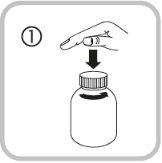
Следуйте следующим шагам при первом приеме сиропа Лапристы:
- Удалите адаптер из шприца для орального применения (рисунок 2).
- Поместите адаптер на верхнюю часть флакона (рисунок 3). Убедитесь, что он хорошо закреплен. Не нужно удалять адаптер после использования.
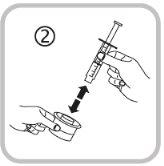
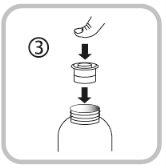
Следуйте следующим шагам каждый раз, когда вы принимаете это лекарство:
- Поместите шприц для орального применения в отверстие адаптера (рисунок 4).
- Поместите флакон вниз (рисунок 5).


- Держите флакон вниз и используйте другую руку, чтобы наполнить шприц для орального применения.
- Потяните за поршень вниз, чтобы наполнить шприц для орального применения небольшым количеством раствора (рисунок 6).
- Нажмите на поршень вверх, чтобы удалить возможные пузырьки (рисунок 7).
- Потяните за поршень вниз до отметки дозы, соответствующей миллилитрам (мл), назначенным вашим врачом (рисунок 8).
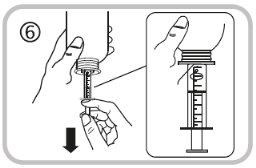
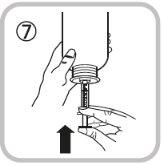
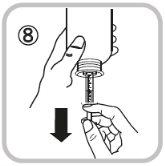
- Поверните флакон до правильного положения (рисунок 9).
- Удалите шприц для орального применения из адаптера (рисунок 10).

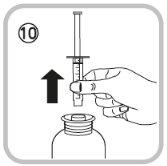
Есть два способа, которые вы можете выбрать для приема лекарства:
- Выпустите содержимое шприца для орального применения в немного воды, нажимая на поршень до конца шприца для орального применения (рисунок 11) - в этом случае вам нужно выпить всю воду (добавьте воду, чтобы было легче пить) или
- Принимайте раствор直接 из шприца для орального применения без воды (рисунок 12) - выпейте все содержимое шприца для орального применения.
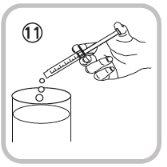
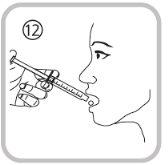
- Закройте флакон крышкой (не нужно удалять адаптер).
- Промойте шприц для орального применения только водой (рисунок 13).
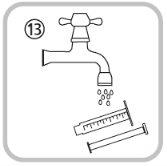
Если вы приняли больше сиропа Лапристы, чем следует
Если вы приняли больше лакозамида, чем следует, проконсультируйтесь с вашим врачом немедленно. Не пытайтесь водить машину.
Вы можете испытать:
- Головокружение.
- Чувство тошноты или рвоты.
- Приступы (судороги), проблемы с сердечным ритмом, такие как медленный, быстрый или нерегулярный пульс, кома или снижение артериального давления с тахикардией и потоотделением.
В случае передозировки или случайного приема проконсультируйтесь немедленно с вашим врачом или фармацевтом или позвоните в Службу токсикологической информации, телефон 91 562 04 20, указав лекарство и количество, принятое.
Если вы забыли принять сироп Лапристы
- Если вы забыли принять дозу в течение 6 часов после назначенной дозы, примите ее как можно скорее.
- Если вы забыли принять дозу после 6 часов после назначенной дозы, не принимайте пропущенную дозу. Вместо этого примите лакозамид в следующий раз, когда вы обычно принимаете его.
- Не принимайте двойную дозу, чтобы компенсировать пропущенные дозы.
Если вы прекратите лечение сиропом Лапристы
- Не прекращайте принимать это лекарство без консультации с вашим врачом, поскольку эпилепсия может появиться снова или ухудшиться.
- Если ваш врач решит прекратить ваше лечение этим лекарством, он даст вам инструкции о том, как постепенно уменьшить дозу.
Если у вас есть другие вопросы о применении этого продукта, проконсультируйтесь с вашим врачом или фармацевтом.
4. Возможные побочные эффекты
Как и все лекарства, это лекарство может вызывать побочные эффекты, хотя не все люди испытывают их.
Побочные эффекты в нервной системе, такие как головокружение, могут быть более выраженными после единой дозы "загрузки".
Сообщите своему врачу или фармацевту, если у вас возникнут следующие побочные эффекты:
Очень частые: могут встречаться более чем у 1 из 10 пациентов
- Головная боль;
- Чувство головокружения или тошноты (наusea);
- Двойное зрение (диплопия).
Частые: могут встречаться до 1 из 10 пациентов
- Проблемы с поддержанием равновесия, тремор, онемение (парестезия) или мышечные спазмы, частые падения и синяки;
- Проблемы с памятью, трудности с мышлением или поиском слов, путаница;
- Быстрые и неконтролируемые движения глаз (нистагмус);
- Размытое зрение;
- Чувство головокружения (вертиго), чувство опьянения;
- Рвота, сухость во рту, запор, изжога, газы в желудке или кишечнике, диарея;
- Уменьшение чувствительности, трудности с артикуляцией слов, нарушение внимания;
- Шум в ушах, как жужжание, свист или писк;
- Раздражительность, проблемы со сном, депрессия;
- Сонливость, усталость или слабость (астения);
- Зуд, высыпания.
Редкие: могут встречаться до 1 из 100 пациентов
- Уменьшение частоты сердечных сокращений, перебои в сердцебиении, нерегулярный пульс или другие изменения в электрической активности сердца (нарушение проводимости);
- Чрезмерное чувство благополучия, видение и/или слышание вещей, которых нет на самом деле;
- Аллергическая реакция на прием лекарства, крапивница;
- Анализы крови могут показать аномалии функции печени, повреждение печени;
- Мысли о самоубийстве или попытки самоубийства: сообщите врачу немедленно;
- Чувство гнева или агрессии, аномальные мысли и/или потеря чувства реальности;
- Тяжелые аллергические реакции, которые вызывают отек лица, горла, рук, ног, лодыжек или нижних частей ног;
- Обморок,
- Трудности с координацией движений или ходьбой.
Частота неизвестна: не может быть оценена по имеющимся данным
- Аномально быстрый сердечный ритм (тахикардия);
- Боль в горле, повышенная температура и частые инфекции. Анализы крови могут показать значительное уменьшение количества определенного типа белых кровяных клеток (агранулоцитоз);
- Тяжелая кожная реакция, которая может включать повышенную температуру и другие симптомы, похожие на грипп, высыпания на лице, обширные высыпания с воспалением лимфатических узлов (увеличенные лимфатические узлы). Анализы крови могут показать увеличение уровня печеночных ферментов и увеличение количества определенного типа белых кровяных клеток (эозинофилия);
- Обширные высыпания с пузырями и отслоением кожи, особенно вокруг рта, носа, глаз и гениталий (синдром Стивенса-Джонсона) и более тяжелая форма, которая вызывает отслоение кожи более чем на 30% поверхности тела (токсическая эпидермальная некролиз).
- Судороги.
Другие побочные эффекты у детей
Дополнительные побочные эффекты, наблюдаемые у детей, были лихорадкой (пирексией), насморком (насофарингитом), болью в горле (фарингитом), снижением аппетита, изменениями поведения, необычным поведением и отсутствием энергии (летаргией). Чувство сонливости (сомноленция) является очень частым побочным эффектом у детей и может встречаться более чем у 1 из 10 детей.
Сообщение о побочных эффектах
Если вы испытываете любой побочный эффект, проконсультируйтесь с врачом или фармацевтом, даже если это возможные побочные эффекты, которые не указаны в этом листке-вкладыше.
Вы также можете сообщить о них напрямую через Испанскую систему фармакологического надзора за лекарствами для человека: www.notificaram.es.
Сообщая о побочных эффектах, вы можете внести свой вклад в предоставление более полной информации о безопасности этого лекарства.
5. Хранение сиропа Лапристы
Храните это лекарство в недоступном для детей месте.
Не используйте это лекарство после истечения срока годности, указанного на коробке и флаконе, после CAD/EXP. Срок годности - последний день месяца, указанного на упаковке.
Не храните в холодильнике.
После открытия флакона сиропа не используйте его после 2 месяцев.
Лекарства не должны выбрасываться в канализацию или мусор. Сдавайте упаковки и лекарства, которые вам больше не нужны, в пункт SIGRE аптеки. Спросите у фармацевта, как правильно утилизировать упаковки и лекарства, которые вам больше не нужны. Таким образом, вы поможете защитить окружающую среду.
6. Состав упаковки и дополнительная информация
Состав сиропа Лапристы
- Активное вещество - лакозамида. 1 мл этого лекарства содержит 10 мг лакозамиды.
- Другие компоненты: жидкий сорбитол 70% (не кристаллизующийся) (Е 420), глицерин, пропиленгликоль (Е 1520), макрогол 4000, хлорид натрия, кармелоза натрия, ацесульфам калия (Е950), ангидрид лимонной кислоты, метилпараоксибензоат натрия (Е219), фруктовый вкус (содержит пропиленгликоль (Е 1520)), аспартам (Е951) и очищенная вода.
Внешний вид продукта и состав упаковки
- Лапристы 10 мг/мл сироп - прозрачная, бесцветная и слегка вязкая жидкость.
- Это лекарство выпускается в флаконе объемом 200 мл.
Коробка сиропа Лапристы включает мерный стакан объемом 25 мл с градуировкой и шприц для перорального использования объемом 10 мл.
- Мерный стакан подходит для дозировки более 20 мл.
Мерный стакан имеет три разных нелинейных шкалы на трех сторонах, что позволяет точно измерять разные дозы. Каждая градуировка сопровождается указанием соответствующего объема в мл. Минимальный извлекаемый объем - 2 мл, что соответствует 20 мг лакозамиды. Максимальный извлекаемый объем - 25 мл, что соответствует 250 мг лакозамиды.
- Шприц для перорального использования объемом 10 мл подходит для дозировки от 1 мл до 20 мл. Заполненный шприц для перорального использования объемом 10 мл соответствует 100 мг лакозамиды. Минимальный извлекаемый объем - 1 мл, что соответствует 10 мг лакозамиды. После этого каждая градуировка (0,25 мл) соответствует 2,5 мг лакозамиды (например, 4 градуировки соответствуют 10 мг).
Владелец разрешения на маркетинг и производитель
Владелец разрешения на маркетинг
Neuraxpharm Spain, S.L.U.
Avda. Barcelona 69,
08970 Sant Joan Despí – Barcelona
Испания
Производитель
neuraxpharm Arzneimittel GmbH
Elisabeth-Selbert-Strasse 23
40764 Langenfeld
Германия
Это лекарство разрешено к маркетингу в государствах-членах ЕЭС под следующими названиями:
Италия: Лапристы
Испания: Лапристы 10 мг/мл сироп ЕФГ
Дата последнего пересмотра этого листка-вкладыша: июль 2023
Другие источники информации
Подробная информация о этом лекарстве доступна на сайте Испанского агентства по лекарствам и медицинским изделиям (AEMPS) http://www.aemps.gob.es/.

Сколько стоит ЛАПРИСТА 10 мг/мл СИРОП в Испании в 2025 году?
Средняя цена на ЛАПРИСТА 10 мг/мл СИРОП в декабрь, 2025 года составляет около 23.49 евро. Финальная стоимость может зависеть от региона, конкретной аптеки и рецептурного статуса. Для точной информации лучше проверить онлайн или в ближайшей аптеке.
- Страна регистрации
- Средняя цена в аптеках23.49 EUR
- Активное вещество
- Требуется рецептДа
- Производитель
- Информация носит справочный характер и не является медицинской рекомендацией. Перед приемом любых препаратов проконсультируйтесь с врачом. Oladoctor не несет ответственности за медицинские решения, принятые на основе этого контента.
- Аналоги ЛАПРИСТА 10 мг/мл СИРОПФорма выпуска: ТАБЛЕТКА, 100 мгАктивное вещество: ЛакосамидПроизводитель: Intas Third Party Sales 2005 S.L.Требуется рецептФорма выпуска: ТАБЛЕТКА, 150 мгАктивное вещество: ЛакосамидПроизводитель: Intas Third Party Sales 2005 S.L.Требуется рецептФорма выпуска: ТАБЛЕТКА, 200 мгАктивное вещество: ЛакосамидПроизводитель: Intas Third Party Sales 2005 S.L.Требуется рецепт
Аналоги ЛАПРИСТА 10 мг/мл СИРОП в других странах
Лучшие аналоги с тем же действующим веществом и терапевтическим эффектом.
Аналог ЛАПРИСТА 10 мг/мл СИРОП в Polska
Аналог ЛАПРИСТА 10 мг/мл СИРОП в Ukraina
Врачи онлайн по ЛАПРИСТА 10 мг/мл СИРОП
Консультация по дозировке, побочным эффектам, взаимодействиям, противопоказаниям и продлению рецепта на ЛАПРИСТА 10 мг/мл СИРОП – по решению врача и с учетом местных правил.







